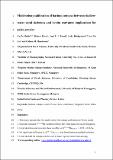Files in this item
Multi-colony calibration of barium isotopes between shallow-water coral skeletons and in-situ seawater : implications for paleo proxies
Item metadata
| dc.contributor.author | Hsieh, Yu-Te | |
| dc.contributor.author | Paver, Robert | |
| dc.contributor.author | Tanzil, Jani T.I. | |
| dc.contributor.author | Bridgestock, Luke | |
| dc.contributor.author | Lee, Jen Nie | |
| dc.contributor.author | Henderson, Gideon M. | |
| dc.date.accessioned | 2023-03-27T09:30:09Z | |
| dc.date.available | 2023-03-27T09:30:09Z | |
| dc.date.issued | 2022-02-15 | |
| dc.identifier | 283736671 | |
| dc.identifier | 5dfc7235-5c03-4a7b-b866-969413fbcd14 | |
| dc.identifier | 85123044077 | |
| dc.identifier.citation | Hsieh , Y-T , Paver , R , Tanzil , J T I , Bridgestock , L , Lee , J N & Henderson , G M 2022 , ' Multi-colony calibration of barium isotopes between shallow-water coral skeletons and in-situ seawater : implications for paleo proxies ' , Earth and Planetary Science Letters , vol. 580 , 117369 . https://doi.org/10.1016/j.epsl.2022.117369 | en |
| dc.identifier.issn | 0012-821X | |
| dc.identifier.other | ORCID: /0000-0001-7636-6090/work/131122772 | |
| dc.identifier.uri | https://hdl.handle.net/10023/27269 | |
| dc.description | Funding: The study was supported by the Royal Society Commonwealth Science Conference Fellow-on Grant (CSC\R1\170048) and the National Research Foundation Singapore (Marine Science Research and Development Programme project P03). | en |
| dc.description.abstract | Barium incorporated in coral skeletons has been widely used as paleo proxies to study terrestrial inputs, upwelling and anthropogenic activities in marine environments. However, these applications often face the challenges of poor replication in the coral skeletal Ba/Ca records from multiple coral colonies and complex Ba sources in coastal environments. Recent studies of Ba isotopes in seawater and deep-sea corals have demonstrated the potential to trace Ba sources and water mixing in the ocean, but there is still a lack of calibrations for Ba isotopes in shallow-water corals. In this study, we present the first multi-colony Ba isotope calibration from three shallow-water Porites lutea corals with the contemporaneous in-situ seawater data from the Singapore Strait. We also report the Ba isotope data in the regional water masses around the study area (e.g. South China Sea, Malacca Strait and Johor River estuary). Singapore water Ba concentrations and isotope compositions show a strong influence of terrestrial inputs, following seasonal salinity and monsoon-driven water-mass mixing between the Malacca Strait and the South China Sea. The coral skeletal δ138/134Ba results are generally consistent between the three coral colonies and time-series data closely follow the seasonal δ138/134Ba variations in seawater. Despite the partition coefficient of Ba having a large uncertainty (DBa = 0.91 ± 0.29), the Ba isotope fractionation between the coral skeletons and seawater is relatively constant (Δ138/134Bacoral-sw = -0.28 ± 0.06‰) and shows no significant difference between these corals. The mechanism controlling Ba incorporation and isotope fractionation in coral skeletons remains unclear, but the evidence clearly indicates that the coral skeletal Ba is originated from dissolved Ba in seawater. The constant offset of Ba isotopes between coral skeletons and seawater allows for reliable records of seawater δ138/134Ba values. Ba isotopes in coral skeletons could be used to reconstruct surface water salinity variability in the Singapore Strait, reflecting monsoon driven changes in regional water mass mixing. | |
| dc.format.extent | 12 | |
| dc.format.extent | 3508444 | |
| dc.language.iso | eng | |
| dc.relation.ispartof | Earth and Planetary Science Letters | en |
| dc.subject | Barium isotopes | en |
| dc.subject | Coral | en |
| dc.subject | Porites lutea | en |
| dc.subject | Calibration | en |
| dc.subject | Singapore Strait | en |
| dc.subject | Paleo proxy | en |
| dc.subject | QL Zoology | en |
| dc.subject | GE Environmental Sciences | en |
| dc.subject | NDAS | en |
| dc.subject | SDG 14 - Life Below Water | en |
| dc.subject | MCC | en |
| dc.subject.lcc | QL | en |
| dc.subject.lcc | GE | en |
| dc.title | Multi-colony calibration of barium isotopes between shallow-water coral skeletons and in-situ seawater : implications for paleo proxies | en |
| dc.type | Journal article | en |
| dc.contributor.institution | University of St Andrews. School of Earth & Environmental Sciences | en |
| dc.identifier.doi | 10.1016/j.epsl.2022.117369 | |
| dc.description.status | Peer reviewed | en |
| dc.identifier.url | https://ora.ox.ac.uk/objects/uuid:ca0391d8-dbe0-4a23-b913-25d19bf2deaa | en |
This item appears in the following Collection(s)
Items in the St Andrews Research Repository are protected by copyright, with all rights reserved, unless otherwise indicated.

